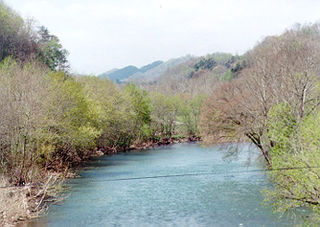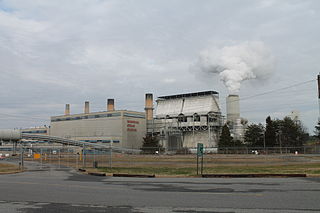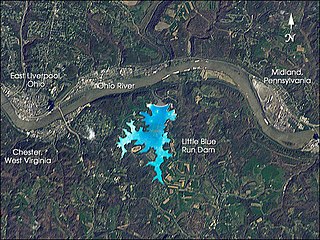
Lake Norman of Catawba is a census-designated place (CDP) in Catawba County, North Carolina, United States. The population was 7,411 at the 2010 census, up from 4,744 at the 2000 census. It is part of the Hickory-Lenoir-Morganton Metropolitan Statistical Area.

Tailings are the materials left over after the process of separating the valuable fraction from the uneconomic fraction (gangue) of an ore. Tailings are distinct from overburden, which is the waste rock or other material that overlies an ore or mineral body and is displaced during mining without being processed.

The Cape Fear River is a 191.08-mile (307.51 km) long blackwater river in east central North Carolina. It flows into the Atlantic Ocean near Cape Fear, from which it takes its name. The river also has several pollutants, ranging from suspended solids and runoff to manmade chemicals like GenX.

The Catawba River originates in Western North Carolina and flows into South Carolina, where it later becomes known as the Wateree River. The river is approximately 220 miles (350 km) long. It rises in the Appalachian Mountains and drains into the Piedmont, where it has been impounded through a series of reservoirs for flood control and generation of hydroelectricity. The river is named after the Catawba tribe of Native Americans, which lives on its banks. In their language, they call themselves "yeh is-WAH h’reh", meaning "people of the river."

The Clinch River is a river that flows southwest for more than 300 miles (480 km) through the Great Appalachian Valley in the U.S. states of Virginia and Tennessee, gathering various tributaries, including the Powell River, before joining the Tennessee River in Kingston, Tennessee.

Fly ash or flue ash, coal ash, and also known as pulverised fuel ash in the United Kingdom, or coal combustion residuals (CCRs), is a coal combustion product that is composed of the particulates (fine particles of burned fuel) that are driven out of coal-fired boilers together with the flue gases. Ash that falls to the bottom of the boiler's combustion chamber (commonly called a firebox) is called bottom ash. In modern coal-fired power plants, fly ash is generally captured by electrostatic precipitators or other particle filtration equipment before the flue gases reach the chimneys. Together with bottom ash removed from the bottom of the boiler, it is known as coal ash. Depending upon the source and composition of the coal being burned, the components of fly ash vary considerably, but all fly ash includes substantial amounts of silicon dioxide (SiO2) (both amorphous and crystalline), aluminium oxide (Al2O3) and calcium oxide (CaO), the main mineral compounds in coal-bearing rock strata.

The Elk River is a tributary of the Kanawha River, 172 miles (277 km) long, in central West Virginia in the United States. Via the Kanawha and Ohio rivers, it is part of the watershed of the Mississippi River.

Sutton Lake is a 1,520-acre (6 km2) reservoir on the Elk River in Braxton and Webster counties, West Virginia. Sutton Lake is located just upstream of Sutton. It was authorized by Congress in the Flood Control Act of 1938. Construction of the dam began in 1956 and was completed in 1961. The dam is 210 feet (64 m) high, 1,178 feet (359 m) long, and constructed of concrete. The lake was named by Congressional action, Public Law 90-46, July 4, 1967.

Mountain Island Lake is a lake northwest of Charlotte, North Carolina created in 1924 to coincide with the building of Mountain Island Hydroelectric Station. It is named after the mountain which appears as an island in the lake, and the surrounding area is identified by the lake's name. The shape of the lake follows the meander of the Catawba River's course, dammed near the Mount Holly Wastewater Plant. Full pond elevation is approximately 647.5 feet (197 m). The lake has around 3,281 acres (13 km2) of surface area and 61 miles (98 km) of shoreline.

Marshall Steam Station is a coal power plant located at 35°35′51″N80°57′53″W in Sherrills Ford, Catawba County, North Carolina, United States and owned by Duke Energy. Named for former company president E.C. Marshall, the station is located on Lake Norman and began commercial operation in 1965.

Coal combustion products (CCPs), also called coal combustion wastes (CCWs) or coal combustion residuals (CCRs), are categorized in four groups, each based on physical and chemical forms derived from coal combustion methods and emission controls:

A coal-fired power station or coal power plant is a thermal power station which burns coal to generate electricity. Coal-fired power stations generate a third of the world's electricity but cause hundreds of thousands of early deaths each year, mainly from air pollution.

The health and environmental impact of the coal industry includes issues such as land use, waste management, water and air pollution, caused by the coal mining, processing and the use of its products. In addition to atmospheric pollution, coal burning produces hundreds of millions of tons of solid waste products annually, including fly ash, bottom ash, and flue-gas desulfurization sludge, that contain mercury, uranium, thorium, arsenic, and other heavy metals. Coal is the largest contributor to the human-made increase of carbon dioxide in Earth's atmosphere.

The Kingston Fossil Plant coal fly ash slurry spill was an environmental and industrial disaster that occurred on Monday December 22, 2008, when a dike ruptured at a coal ash pond at the Tennessee Valley Authority's Kingston Fossil Plant in Roane County, Tennessee, releasing 1.1 billion US gallons of coal fly ash slurry. The coal-fired power plant, located across the Clinch River from the city of Kingston, used a series of ponds to store and dewater the fly ash, a byproduct of coal combustion. The spill released a slurry of fly ash and water, which traveled across the Emory River and its Swan Pond embayment, onto the opposite shore, covering up to 300 acres (1.2 km2) of the surrounding land. The spill damaged multiple homes and flowed into nearby waterways including the Emory River and Clinch River, both tributaries of the Tennessee River. It was the largest industrial spill in United States history.

An ash pond, also called a coal ash basin or surface impoundment, is an engineered structure used at fossil fuel power stations for the disposal of two types of coal combustion products: bottom ash and fly ash. The pond is used as a landfill to prevent the release of ash into the atmosphere. Although the use of ash ponds in combination with air pollution controls decreases the amount of airborne pollutants, the structures pose serious health risks for the surrounding environment.

The Dan River Steam Station is a power plant in Eden, North Carolina, owned by Duke Energy. The plant comprises three natural gas-fueled combustion turbines, which began operation in 1968.), and two natural gas-fueled combined cycle turbines are planned for the near future. A coal-fired electrical power plant at the site ceased operation in 2012.

Little Blue Run Lake or Little Blue Run is the largest coal ash impound in the United States. FirstEnergy owns the site, located in Western Pennsylvania and parts of the Northern "Panhandle" of West Virginia, and has disposed of billions of gallons of coal waste into the body of water. Several court cases have been brought against the company as a result of the damage caused by the company's practices at the site.

In February 2014, an Eden, North Carolina facility owned by Duke Energy spilled 39,000 tons of coal ash into the Dan River. The company later pled guilty to criminal negligence in their handling of coal ash at Eden and elsewhere and paid extremely minimal fines of over $5 million, compared to its $24 billion revenue in 2014. The U.S. Environmental Protection Agency (EPA) has since been responsible for overseeing cleanup of the waste. EPA and Duke Energy signed an administrative order for the site cleanup.
The H.F. Lee Energy Complex, formerly the Goldsboro Plant, is an electrical power generating complex operated by Duke Energy. The power complex was originally owned by the Carolina Power & Light Company, which inaugurated a coal-fired power plant in 1951. Two more coal plants were added in 1952 and 1962, and then oil-fueled turbines were added in 1967–71. In 2012 these units were shut down and replaced by four gas-fired units. The Quaker Neck Lake was built as a cooling pond for the coal-fired power stations, and is still used to supply cooling water. It was originally impounded by a low dam on the Neuse River, but in 1998 the dam was removed, while the lake remained contained in an earthen wall. This change allowed fish to migrate further upstream for spawning. Ash ponds near the lake hold toxic coal ash. There are plans to remove and recycle or bury the ash.



















